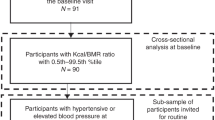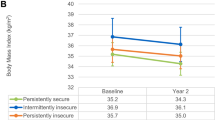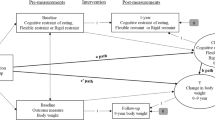Abstract
Background/objectives:
Neophobia, pickiness and diet variety are associated with diet quality and health outcomes in young children. Limited research has examined these associations among youth with type 1 diabetes (T1D), a population at risk for poor health outcomes when dietary quality is inadequate.
Subjects/methods:
Youth (n=252, age 13.2±2.8 years, 92% white, diabetes duration 6.3±3.4 years) with T1D and their parents completed 3-day youth diet records; parents completed questionnaires regarding youth neophobia, pickiness and diabetes management adherence. Medical records provided biomedical data. Dietary quality indicators included Nutrient-Rich Foods Index 9.3 (NRF9.3), Healthy Eating Index-2005 (HEI-2005), Whole Plant Food Density (WPFD) and key single nutrients. Dietary variety was operationalized as a count of 20 recommended food groups consumed. Relationships of dietary quality and diabetes management adherence with neophobia, pickiness and dietary variety as independent variables were examined using multiple linear regression analyses adjusted for total energy intake, age, height and weight.
Results:
In multiple linear regression analyses, NRF9.3 and HEI-2005 were each inversely associated with neophobia and pickiness, and positively associated with dietary variety. WPF and potassium were each positively associated and saturated fat was inversely associated with dietary variety. However, in models simultaneously including neophobia, pickiness and dietary variety as independent correlates of dietary quality, only relationships with dietary variety remained significant. Diabetes management adherence was negatively associated with both neophobia and pickiness and positively associated with dietary variety.
Conclusions:
Findings suggest that increasing dietary variety may contribute toward improved dietary quality among youth with T1D, despite potentially adverse influences of neophobia and pickiness.
This is a preview of subscription content, access via your institution
Access options
Subscribe to this journal
Receive 12 print issues and online access
$259.00 per year
only $21.58 per issue
Buy this article
- Purchase on Springer Link
- Instant access to full article PDF
Prices may be subject to local taxes which are calculated during checkout
Similar content being viewed by others
References
US Department of Agriculture and US Department of Health and Human Services. Dietary Guidelines for Americans, 2010 7th edn. US Government Printing Office: Washington, DC, USA, 2010.
Foote J, Murphy S, Wilkens L, Basiotis P, Carlson A . Dietary variety increases the probability of nutrient adequacy among adults. J Nutr 2004; 134: 1779–1785.
Institute of Medicine. Dietary Reference Intake for Energy, Carbohydrate, Fiber, Fat, Fatty Acids, Cholesterol, Protein, and Amino Acids (Macronutrients). Institute of Medicine, National Academies Press: Washington, DC, USA, 2005.
Wardle J, Cooke L . Genetic and environmental determinants of children's food preferences. Br J Nutr 2008; 99 (Suppl 1), S15–S21.
Cooke L, Wardle J, Gibson E . Relationship between parental report of food neophobia and everday food consumption in 2–6-year-old children. Appetite 2003; 41: 205–206.
Falciglia G, Couch S, Gribble L, Pabst S, Frank R . Food neophobia in childhood affects dietary variety. J Am Diet Assoc 2000; 100: 1474–1478. 1481.
Galloway A, Lee Y, Birch L . Predictors and consequences of food neophobia and pickiness in young girls. J Am Diet Assoc 2003; 103: 692–698.
Jacobi C, Agras W, Bryson S, Hammer L . Behavioural validation, precursors and concomitants of picky eating in childhood. J Am Acad Child Adolesc Psychiatr 2003; 42: 76–84.
Galloway A, Fiorito L, Lee Y, Birch L . Parental pressure, dietary patterns, and weight status among girls who are ‘picky eaters’. J Am Diet Assoc 2005; 105: 541–548.
Carruth B, Skinner J, Houck J, Moran J III, Colleta F, Ott D . The phenomenon of ‘picky eater’: a behavioral marker in eating patterns of toddlers. J Am Coll Nutr 1998; 17: 180–186.
Skinner J, Caruth B, Bounds W, Zeigler P . Children's food preferences: a longitudinal analysis. J Am Diet Assoc 2002; 102: 1638–1647.
Dovey T, Staples P, Gibson E, Halford JCG . Food neophobia and 'picky/fussy' eating in children: a review. Appetite 2008; 50: 181–193.
Nicklaus S, Boggio V, Chababnet C, Issanchou S . Prospective study of food variety seeking in childhood, adolescence and early adult life. Appetite 2005; 44: 289–297.
Rigal N, Frelut M, Monneuse M, Hladik C, Simmen B, Pasquet P . Food neophobia in the context of a varied diet induced by weight reduction program in massively obese adolescents. Appetite 2006; 46: 207–214.
Silverstein J, Klingensmith G, Copeland K, Plotnick L, Kaufman F, Laffel L et al. Care of children and adolescents with type 1 diabetes: a statement of the American Diabetes Association. Diabetes Care 2005; 28: 186–212.
Rovner A, Nansel T . Are children with type 1 diabetes consuming a healthful diet?: a review of the current evidence and strategies for dietary change. Diabetes Educ 2009; 35: 97–107.
Nansel T, Haynie D, Lipsky L, Laffel L, Mehta S . Multiple indicators of poor diet quality in children and adolescents with type 1 diabetes are associated with higher body mass index percentile but not glycemic control. J Acad Nutr Diet 2012; 112: 1728–1735.
Baker J, Olsen L, Sorensen TIA . Childhood body-mass index and the risk of coronary heart disease in adulthood. N Engl J Med 2007; 357: 2329–2337.
Gellar L, Schrader K, Nansel T . Healthy eating practices: perceptions, facilitators, and barriers among youth with diabetes. Diabetes Educ 2007; 33: 671–679.
Cooke L, Haworth C, Wardle J . Genetic and environmental influences of children's food neophobia. Am J Clin Nutr 2007; 86: 428–433.
Murphy S, Foote J, Wilkens L, Basiotis P, Carlson A, White K et al. Simple measures of dietary variety are associated with improved dietary quality. J Am Diet Assoc 2006; 106: 425–429.
US Department of Health and Human Services and US Department of Agriculture. Dietary Guidelines for Americans 6th edn. US Goverment Printing Office: Washington, DC, USA, 2005.
Kennedy E, Ohls J, Carlson S, Fleming K . The healthy eating index: design and implications. J Am Diet Assoc 1995; 95: 1103–1108.
Guenther P, Reedy J, Krebs-Smith S, Reeve B, Basiotis P Development and evaluation of the Healthy Eating Index-2005: Technical Report in US Department of Agriculture Center for Nutrition Policy and Promotion website, 2007. Available at http://www.cnpp.usda.gov/Publications/HEI/HEI-2005/HEI-2005TechnicalReport.pdf (accessed on 3 March 2013).
Fulgoni V 3rd, Keast D, Drewnowski A . Development and validation of the nutrient-rich foods index: a tool to measure nutritional quality of foods. J Nutr 2009; 139: 1549–1554.
Lipsky LM, Cheon K, Nansel TR, Albert PS . Candidate measures of whole plant food intake are related to biomarkers of nutrition and health in the US population (Nation Health and Nutrition Examination Survey 1999–2002). Nutr Res 2012; 32: 251–259.
Hu F . Plant-based foods and prevention of cardiovascular disease: an overview. Am J Clin Nutr 2003; 78: 544S–551S.
Wilson P . Diabetes mellitus and coronary heart disease. Am J Kidney Dis 1998; 32 (Suppl 3), S89–S100.
Astrup A, Dyerberg J, Elwood P, Hermansen K, Hu F, Jakobsen M et al. The role of reducing intakes of saturated fat in the prevention of cardiovascular disease: where does the evidence stand in 2010? Am J Clin Nutr 2011; 93: 684–688.
Umesawa M, Iso H, Date C, Yamamoto A, Toyoshima H, Watanabe Y et al. Relations between dietary sodium and potassium intakes and mortality from cardiovascular disease: the Japan Collaborative Cohort Study for Evaluation of Cancer Risks. Am J Clin Nutr 2008; 88: 195–202.
Johnson R, Appel L, Brands M, Howard B, Lefevre M, Lustig R et al. Dietary sugars intake and cardiovascular health: a scientific statement from the American Heart Association. Circulation 2009; 120: 1011–1020.
Mehta S, Volkening L, Nansel T, Lawlor M, Higgins L, Laffel L . Validation of a self-report measure to assess adherence in youth with type 1 diabetes. Diabetes 2010; 59 (Suppl 1), A80 (abstract).
Cooke L, Wardle J, Gibson E, Sapochnik M, Sheiham A, Lawson M . Demographic, familial and trait predictors of fruit and vegetable consumption by preschool children. Public Health Nutr 2004; 7: 295–302.
Cooke L, Carnell S, Wardle J . Food neophobia and mealtime food consumption in 4–5 year old children. Int J Behav Nutr Physical Act 2006; 6: 3–14.
Aslander-van Vliet E, Smart C, Waldron S . Nutritional management in childhood and adolescent diabetes. Pediatr Diabetes 2007; 8: 323–339.
Mehta S, Haynie D, Higgins L, Bucey N, Rovner A, Volkening L et al. Emphasis on carbohydrates may negatively influence dietary patterns in youth with type 1 diabetes. Diabetes Care 2009; 32: 2174–2176.
Sullivan S, Birch L . Infant dietary experience and acceptance of solid foods. Paediatrica 1994; 93: 271–277.
Wardle J, Herrera M, Cooke L, Gibson E . Modifying children's food preferences: the effects of exposure and reward on acceptance of an unfamiliar vegetable. Eur J Clin Nutr 2003; 57: 341–348.
Savage J, Fisher J, Birch L . Parental influence on eating behavior: Conception to adolescence. J Law Med Ethics 2007; 35: 22–34.
Tseng A, Biagioli F . Counseling on early childhood concerns: sleep issues, thumb sucking, picky eating, and school readiness. Am Fam Physician 2009; 80: 139–142.
Wardle J, Cooke L, Gibson C, Sapochnik M, Sheiham A, Lawson M . Increasing children's acceptance of vegetables: a randomised trial of guidance to parents. Appetite 2003; 40: 155–162.
Birch L . Effects on peer models' food choices and eating behaviors on preschoolers' food preferences. Child Dev 1980; 51: 489–496.
Harper L, Sanders K . The effect of adults' eating on young children's acceptance of unfamilair foods. J Exp Child Psychol 1975; 20: 206–214.
Hobden K, Pliner P . Effects of a model on food neophobia in humans. Appetite 1995; 25: 101–114.
Mueller M, Piazza C, Patel M, Kelley M, Pruett A . Increasing variety of foods consumed by blending nonpreferred foods into preferred foods. J Appl Behav Anal 2004; 37: 159–170.
Tiger J, Hanley G . Using reinforcer pairing and fading to increase the milk consumption of a preschool child. J Appl Behav Anal 2006; 39: 399–403.
Wildes JE, Zucker NL, Marcus MD . Picky eating in adults: results of a web-based survey. Int J Eat Disord 2012; 45: 575–582.
Quick V, Byrd-Bredbenner C, Neumark-Sztainer D . Chronic illness and disordered eating: a discussion of the literature. Adv Nutr 2013; 4: 277–286.
Ackard D, Neumark-Sztainer D, Schmitz K, Hannan P, Jacobs DJ . Disordered eating and body dissatisfaction in adolescents with type 1 diabetes and a population-based comparison sample: comparitive prevalence and clinical implications. Ped Diabetes 2008; 9: 312–319.
Acknowledgements
This research was supported by the intramural research program of the National Institutes of Health, Eunice Kennedy Shriver National Institute of Child Health and Human Development, Contract Number HHSN267200703434C.
Author information
Authors and Affiliations
Corresponding author
Ethics declarations
Competing interests
The authors declare no conflict of interest.
Rights and permissions
About this article
Cite this article
Quick, V., Lipsky, L., Laffel, L. et al. Relationships of neophobia and pickiness with dietary variety, dietary quality and diabetes management adherence in youth with type 1 diabetes. Eur J Clin Nutr 68, 131–136 (2014). https://doi.org/10.1038/ejcn.2013.239
Received:
Revised:
Accepted:
Published:
Issue Date:
DOI: https://doi.org/10.1038/ejcn.2013.239
Keywords
This article is cited by
-
Growth and body composition in children who are picky eaters: a longitudinal view
European Journal of Clinical Nutrition (2019)
-
Young Children with Type 1 Diabetes: Challenges, Research, and Future Directions
Current Diabetes Reports (2014)



